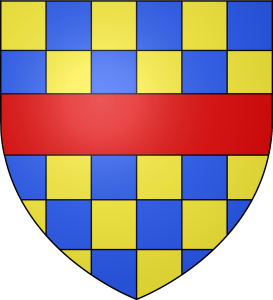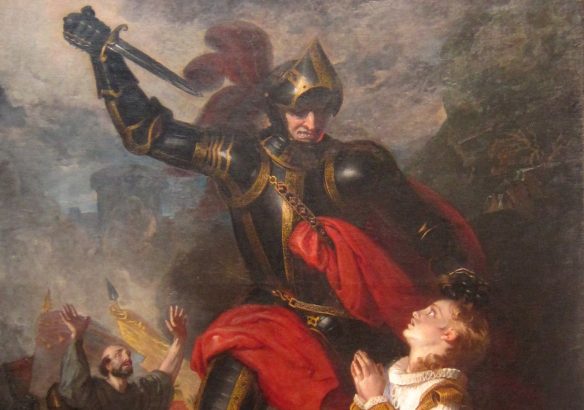John, 9th Baron Clifford Warden of Western Marches
On 8 April 1460 John Clifford was appointed Warden of the West Marches. John Clifford, 9th Baron Clifford was a young man in 1460. He had inherited his father’s title and estates following his father’s death in the First Battle of St. Albans.
Hostilies between northern nobles
Spurred on by anger at his father’s bloody end and a longstanding rivalry with the Neville family, Clifford had become increasingly involved in local and national politics.
Baron Clifford and the Loveday of 1458
The bickering between the Neville family and the Earl of Northumberland, to whom Clifford allied himself, had boiled over not only at St. Albans but in skirmishes and attempted ambushes. When the Loveday of 1458 took place, it required compensation to be paid to Clifford by the Neville’s.
Baron Clifford appointed Warden of the Western Marches
Those Loveday agreements did not last for long. Local clashes continued, and the factionalism on the national stage erupted into war, at Blore Heath, in 1459. Soon the leading Yorkists had fled into exile, followed by their being attained at the Parliament of Devil’s.
In the period of Yorkist exile, Baron Clifford was granted many Neville lands in the north and the role of Warden of the Western Marches.
Military function of Wardens of the Marches
The role of warden of the western marches placed Clifford in command of defences against Scottish invasion. In doing so, it also provided him with control over the North West’s military capabilities, command of castles and management of the well-oiled system of array.
As a result, Clifford rose in significance as he wielded a lot of power. This was to be tested in the coming year.
Biography of John, 9th Baron Clifford
CLIFFORD, JOHN de, ninth Baron Clifford (1435?–1461), son of Thomas, eighth baron Clifford [q. v.], was born in 1435 or 1436 (Escheat Rolls, iv. 272). He makes his first appearance in February 1458, when, together with Somerset and the Earl of Northumberland, he is found ‘with a grete power’ lodged without ‘the walls of London aboute Temple barre and Westmynstre,’ clamouring for compensation for the death of his father at St. Albans.

Loveday to the Parliament of Devils
On this occasion the king and his council intervened, and ordered the Duke of York and the Earls of Salisbury and Warwick to establish masses for the souls of the slain nobles and to pay their representatives ‘a notable sum of money’ (English Chronicle, ed. Davies, 77, 78). Clifford seems now to have been perfectly reconciled with his former enemies, and his name is found as one of the lords attainted with York, Warwick, and Salisbury, after the battle of Blore Heath, at the parliament of Coventry in November 1459 (ib. 84).
Baron Clifford, Warden of Scotch Marches
About the same time (38 Henry VI) he was made commissary-general of the Scotch marches (Dugdale), and a conservator of the truce with Scotland (Rymer, xi. 434). In July 1460 he was summoned to parliament (Dignity of a Peer, iii. 916).
John, 9th Baron Clifford slays Edmund, Earl of Rutland
He was one of the Lancastrian leaders at the battle of Wakefield (Eng. Chr. 107) in December 1460, where he is reported to have slain the Earl of Rutland, the young son of the Duke of York, with his own hands (Hall). For his acts of cruelty he is said to have received the by-name of ‘the Butcher’ (Dugdale). In the same battle he is charged with having cut off the head of the dead Duke of York and presented it decked with a paper crown to Queen Margaret (Holinshed).
2nd St. Albans and death at Dintingdale
Two months later he was present at the second battle of St. Albans (February 1461), but was slain within six weeks at Ferrybridge, on the eve of the battle of Towton (Gregory, Chronicle, 217).

Posthumous attainder of John, 9th Baron Clifford
The same year he was attainted by act of parliament (Escheat Rolls, iv. 327). His barony of Skipton went to Sir William Stanley, that of Westmoreland to Richard of Gloucester.
The Shepherd Lord
He left three children, of whom the eldest, Henry (d. 1523) [q. v.], is the hero of one of Wordsworth’s happiest poems. The romantic story of this noble’s early years, and how he was brought up as a shepherd on his father’s estates till he was restored to his full honours on the accession of Henry VII, can be traced back at least as far as the middle of the sixteenth century (1548), when it makes its appearance in Hall’s ‘Chronicle.’ Hall, however, and Holinshed following him, give the name of this noble as Thomas, by mistake for Henry. Of Clifford’s other children, Richard died abroad, while Elizabeth married Robert, son and heir of Sir John Aske (Dugdale).
Bibliography
[Dugdale’e Baronage, i. 342-3; English Chronicles of the reigns of Richard II-Henry VI, ed. Davies (Camden Society), pp. 77, 78, 84, &c.; Escheat Rolls, iv. 272, 327, &c.; Gregory’s Chronicle of London, ed. Gairdner (Camden Society), pp. 209, 217; Hall’s Chronicle, ed. Ellis (1809), pp. 250-1, 253-5; Grafton’s Chronicle, ed. Ellis, i. 671, 676; Holinshed’s Chronicle, ed. Ellis, iii. 268, 277; Fabyan’s Chronicle, ed. Ellis, p. 639; Paston Letters, ed. Gairdner, i. 425, ii. 5,6; Registrum Abbatiæ Johannis Whethamstede, i. 299, 393; Report on the Dignity of a Peer, vol. iii. The authority for the details of Lord Clifford’s brutal treatment of the Duke of York and the Earl of Rutland is Hall, who, however, it must be remembered, wrote from eighty to ninety years after the battle of Wakefield. From Hall the story passed to Holinshed, and from him to Hume and our later English historians.]Credits
The text in the biography part of this page is public domain [above that heading is not]. It is sourced from Dictionary of National Biography, 1885-1900, Volume 11, Clifford, John de by Thomas Andrew Archer
Images
Clifford Arms, via Wikipedia [Public Domain]
Map of routes to Ferrybridge, Dintingdale, and Towton. Created by Zenta Brice for exclusive use by Dan Moorhouse. All rights reserved.
